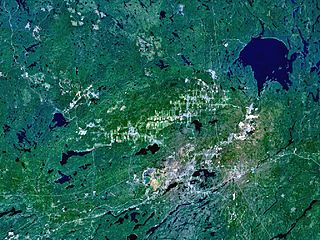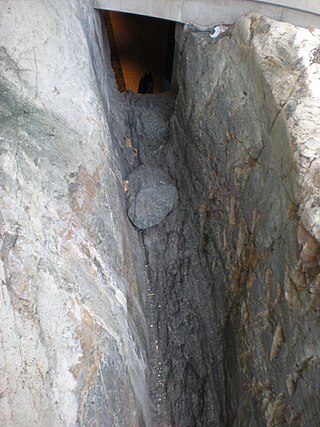
Sudbury, officially the City of Greater Sudbury, is the largest city in Northern Ontario by population, with a population of 166,004 at the 2021 Canadian Census. By land area, it is the largest in Ontario and the fifth largest in Canada. It is administratively a single-tier municipality and thus is not part of any district, county, or regional municipality. The City of Greater Sudbury is separate from, but entirely surrounded by the Sudbury District. The city is also referred to as "Ville du Grand Sudbury" among Francophones.

Vale Canada Limited is a wholly owned subsidiary of the Brazilian mining company Vale. Vale's nickel mining and metals division is headquartered in Toronto, Ontario, Canada. It produces nickel, copper, cobalt, platinum, rhodium, ruthenium, iridium, gold, and silver. Prior to being purchased by CVRD in 2006, Inco was the world's second largest producer of nickel, and the third largest mining company outside South Africa and Russia of platinum group metals. It was also a charter member of the 30-stock Dow Jones Industrial Average formed on October 1, 1928.

Walden was a town in the Canadian province of Ontario, which existed from 1973 to 2000. Created as part of the Regional Municipality of Sudbury when regional government was introduced, the town was dissolved when the city of Greater Sudbury was incorporated on January 1, 2001. The name Walden continues to be informally used to designate the area.

Nickel Centre was a town in Ontario, Canada, which existed from 1973 to 2000.

The Sudbury Basin, also known as Sudbury Structure or the Sudbury Nickel Irruptive, is a major geological structure in Ontario, Canada. It is the third-largest known impact structure on Earth, as well as one of the oldest. The structure, the eroded remnant of an impact crater, was formed by the impact of an asteroid 1.849 billion years ago in the Paleoproterozoic era.
Falconbridge Limited was a Toronto, Ontario-based natural resources company with operations in 18 countries, involved in the exploration, mining, processing, and marketing of metal and mineral products, including nickel, copper, cobalt, and platinum. It was listed on the TSX and NYSE (FAL), and had revenue of US$6.9 billion in 2005. In August 2006, it was absorbed by Swiss-based mining company Xstrata, which had formerly been a major shareholder.

Science North is an interactive science museum in Sudbury, Ontario, Canada.
James K. Gordon is a Canadian politician who served as mayor of Sudbury, Ontario from 1976 to 1981 and from 1991 to 2003, and as a Member of Provincial Parliament for the provincial electoral district of Sudbury from 1981 to 1987. He briefly served in the Executive Council of Ontario, holding the position of Minister of Government Services in 1985.

The Big Nickel is a nine-metre replica of a 1951 Canadian nickel, located at the grounds of the Dynamic Earth science museum in Greater Sudbury, Ontario, Canada, and is the world's largest depiction of a coin. The twelve-sided nickel is located on a small hill overlooking the intersection of Municipal Road 55 and Big Nickel Drive at the westernmost end of the Gatchell neighbourhood.

The Ministry of Energy, Northern Development and Mines (MENDM) was the ministry responsible for developing a safe, reliable and affordable energy supply across the province, overseeing Ontario’s mineral sector and promoting northern economic and community development. The ministry's head office was located in Sudbury. The last Minister of Northern Development and Mines was Hon. Greg Rickford. The Ministry's programs also included the Northern Ontario Heritage Fund, and the creation and funding of local services boards to provide essential services in remote Northern Ontario communities which are not served by incorporated municipal governments.

This is a list of neighbourhoods in the urban core of Greater Sudbury, Ontario. This list includes only those neighbourhoods that fall within the pre-2001 city limits of Sudbury — for communities within the former suburban municipalities, see the articles Capreol, Nickel Centre, Onaping Falls, Rayside-Balfour, Valley East and Walden.

Creighton Mine is an underground nickel, copper, and platinum-group elements (PGE) mine. It is presently owned and operated by Vale Limited in the city of Greater Sudbury, Ontario, Canada. Open pit mining began in 1901, and underground mining began in 1906. The mine is situated in the Sudbury Igneous Complex (SIC) in its South Range geologic unit. The mine is the source of many excavation-related seismic events, such as earthquakes and rock burst events. It is home to SNOLAB, and is currently the deepest nickel mine in Canada. Expansion projects to deepen the Creighton Mine are currently underway.
The Northern Ontario Heritage Fund Corporation (NOHFC) is a Crown corporation and development agency of the Ministry of Northern Development and Mines in the Canadian province of Ontario, whose purpose is to provide funding and program support to foster economic development in the economically disadvantaged Northern Ontario region.

The Greater Sudbury Museums are a network of four small community history museums in Greater Sudbury, Ontario, Canada. Three of the four are located on heritage properties in different neighbourhoods within the city, and the fourth is located in a library facility.

Copper Cliff South Mine is an underground nickel mine in Copper Cliff, Ontario, Canada. It is owned and operated by Vale Canada Limited.
Carl Michael Lesher is an American geologist. He is an authority on the geology and origin of nickel-copper-platinum group element deposits, especially those associated with komatiites, their physical volcanology and localization, the geochemistry and petrology of associated rocks, and controls on their composition.
The Mineral Exploration Research Centre (MERC) is a semi-autonomous research centre associated with the Harquail School of Earth Sciences at Laurentian University in Sudbury Ontario, Canada, and one of the largest mineral exploration research-teaching clusters in the world. MERC is housed in the Willett Green Miller Mineral and Mining Research Centre on the Laurentian University campus, together with the Ontario Geological Survey, Ontario Geoscience Laboratories, the John B. Gammon Mines Library, and the administrative offices of the Minerals and Mining Division of the Ontario Ministry of Northern Development and Mines.
The economy of Greater Sudbury, Ontario was dominated by the mining industry for much of the city's history. In recent decades, however, the city has diversified to establish itself as an emerging centre in a variety of industries, including finance, business, tourism, health care, education, government, film and television production, and science and technology research. Many of these industries reflect the city's position as a regional service centre for Northeastern Ontario.
NORCAT is a not for profit technology and innovation centre headquartered in Greater Sudbury, Ontario, Canada. NORCAT provides health and safety training for the mining industry, occupational health and safety services, and product development assistance to small, medium and large industrial enterprises.

Creighton fault is a major fault line through the Sudbury Basin in Canada. It has a mapped length of 56 km, a throw of over 600m, and a shear zone 30m wide, and runs east–west through Lake Ramsey and the Creighton mine. The fault is the raison-d'etre of Greater Sudbury, and plays host to countless magmatic orebodies.













